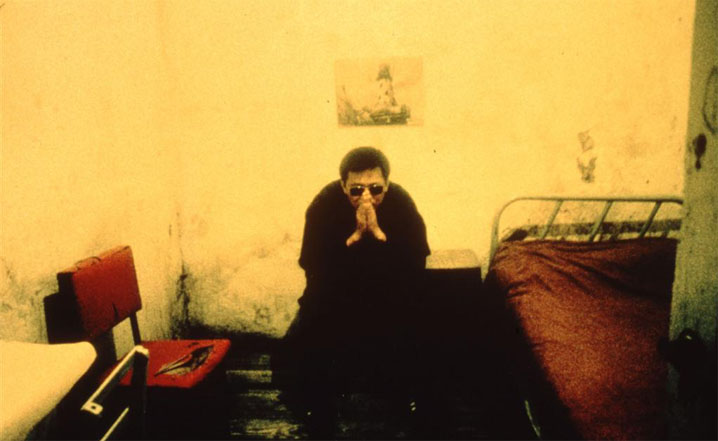
“Everything is blooming most recklessly; if it were voices instead of colors, there would be an unbelievable shrieking into the heart of the night.”
The poet Rainer Maria Rilke, long known as a voice of the most ineffable of human solitudes and longing, has much to offer in ways of understanding the work of Hong Kong auteur Wong Kar-wai. Rilke, a significant character in prefiguring modernism, sang the insufficiency of the human condition, man’s tendency to find himself alone despite the abundance of beauty in life and all of its possibility.
Film director Wong Kar-wai captures this same essence of individuals’ alienations from each other, and the resulting emotional – and volatile – anxiety. Wong, too, is a poet; his character’s inner lives bloom recklessly under the florescent lights of Hong Kong nights and behind doors in rooms of modern isolation. Rather than cry out, they retreat inward. Wong Kar-wai’s films thusly contemplate the human condition in all of its eternal and contemporary implications.
These entries exemplify the director’s preoccupation with probing the most intangible of human desires.
1. As Tears Go By (1989)
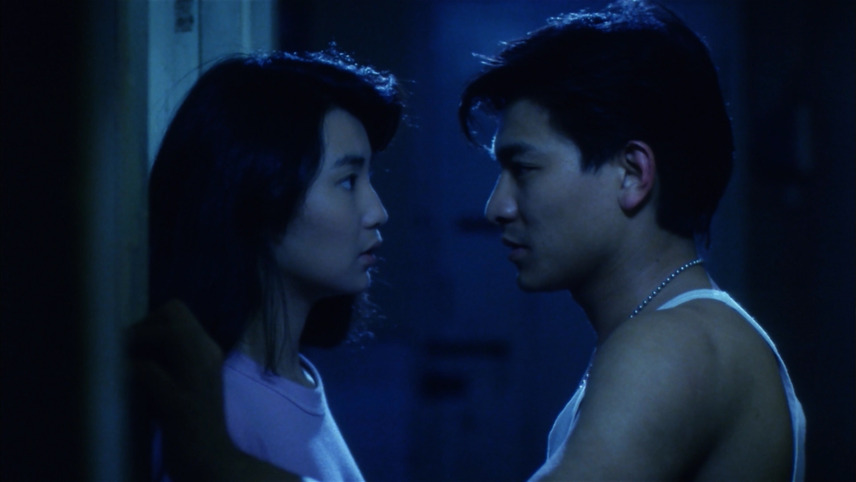
This feature-length directorial debut establishes many of what would become Wong Kar-wai’s trademarks, both thematically and aesthetically. The film marks the first collaboration between the director and Hong Kong actress Maggie Cheung. As Tears Go By tells the story of a young Hong Kong underground up-and-comer who is torn between loyalty and love. The disturbance of his shy cousin appearing in his life sparks the conflict between past and present.
Until this moment the protagonist’s life is unchanging, unexamined. His cousin becomes the object of his longing, representative of a future he had never before considered. As the protagonist is drawn toward this newly realized future, he is inevitably pulled back by his violent past; gang loyalties and a sense of responsibility force him to depart from his idyllic future back to the Hong Kong underground.
The geographical and temporal displacement of Wong’s characters are significant features of his cinema: characters frequently travel back and forth between places on the simplest of whims. However, these efforts to confront their spatial and temporal separations are often in vain. Even when the protagonist realizes his potential for happiness, his link to the past perpetually anchors him in the present, unable to move on. The character’s awareness of this connection is what decidedly seals his fate.
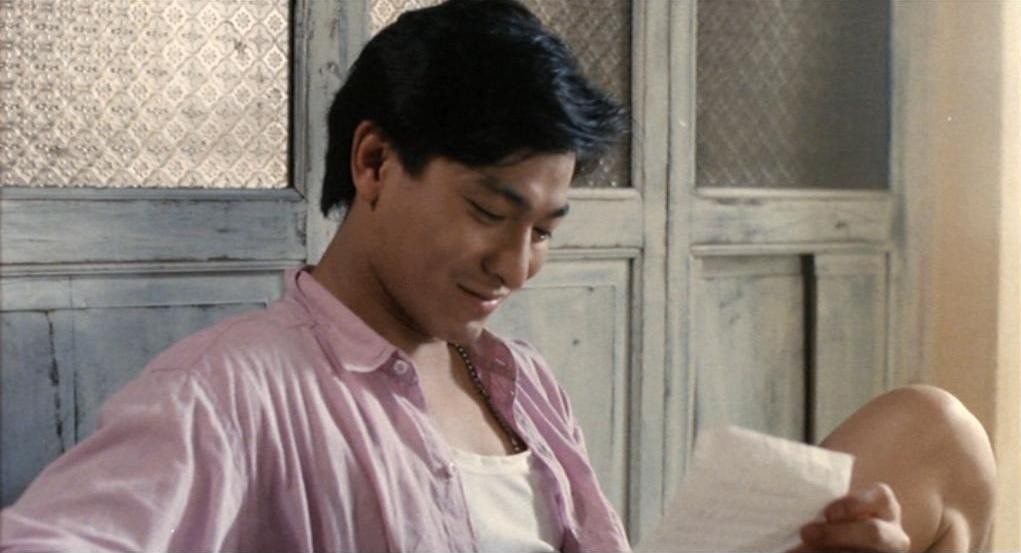
Wong Kar-wai’s aesthetic predilections are apparent from this debut. In the opening scene, the main character is woken by his aunt calling, and she tells him that she’ll call back later. However, only two cuts and seven seconds separate the now from later; with little changing aesthetically this is a jarring non-representation of time. This is director Wong Kar-wai preparing the audience for the tenuity of chronology in this film, and in his work to come.
At the end of the first act the protagonist’s emptiness and longing are realized in a moment which uses a trademark Wong Kar-wai device, voiceover. In this case, it is the cousin who has now departed for home reading the letter she has written to her cousin. Images of the main character reading the letter are cross-cut with images of his empty apartment, his cousin traveling home, and the landscape. This is a frequent device of Wong’s to convey the poetics and mechanical processes of memory, nostalgia, and self-reflection.
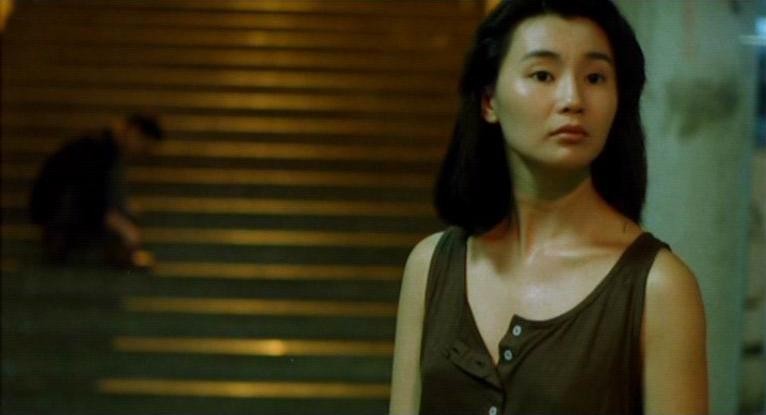
Wong’s conceptions of time transcend narrative into the actual means of production, such as his manipulation of film speed. In a process which Wong would later perfect with cinematographer and frequent collaborator Christopher Doyle, the images are shot at a low frame rate and then step-processed at an even slower rate onto the finished film stock to restore the action to its real time length.
The resulting images are confounding, neither slow- nor fast-motion, but something altogether separate from real-time. They are distorted, jerking forward, blurring lights and colors across frames. Not to be confused with the ethereal, these images are dreamlike in a more jarring way. In As Tears Go By, Wong uses this technique to create a internalized depiction of violence and vengeance. It is an ultra-personal scene which reveals the depths of the main character’s loyalty. The process is used again at the end of the film in a similarly poetic way, as if to comment on the inevitably of the main character’s fate.
As Tears Go By is Wong Kar-wai’s first and most straightforward feature-length film. Despite its linearity and narrative cohesion, it is only the jumping-off point for his explorations of time, place, love, and longing.
2. Days of Being Wild (1990)
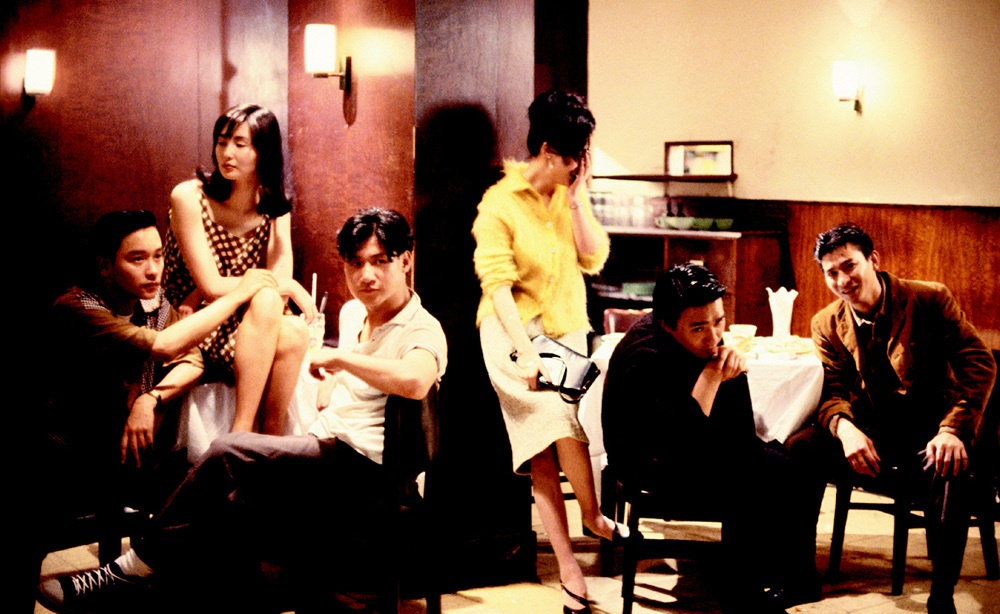
If Wong Kar-wai’s feature-length debut presented the themes he would go on to explore with an almost-obsessive rigor, then his second film established him as an authentic voice in the unfathomable landscapes of human suffering. Set in a poignantly rendered 1960s Hong Kong, Days of Being Wild, as the title suggests, is about the search for intimate connection, a quest for a sense of identity and purpose, and the consequences of reckless love.
The film popularized a genre of Hong Kong films known for its art-house aesthetic, relying on the ability of actors to sustain the emotional arcs of their characters through the mundane aspects of daily life rather than a strict adherence to plot. The film marks the first collaboration between Wong Kar-wai and cinematographer Christopher Doyle, and examples such trademarks as heavily saturated and mixed lighting sources, the manipulation of film speed, and images otherwise distorted via focal length, filtration, camera movement, etc.
The three main cast from Wong’s debut return: Maggie Cheung stars as Su Li Zhen, a young snack shop worker jilted by a handsome heartbreaker, while Jacky Cheung resumes his role as an emotionally-charged sidekick, and Tears star Andy Lau takes up the quiet role of a lonely night patrolman. Aside from working with the best actors and actresses of Hong Kong cinema, Wong’s casting also serve a thematic purpose.
Past collaborators return in similar – sometimes nearly-identical – roles, a commentary on the nature of identity and memory. His characters, removed from all temporal and geographical context, are perpetually longing, always searching for fulfillment and purpose. Days of Being Wild also constitutes the first entry into a thinly-veiled trilogy continued ten years later in In the Mood for Love (2000) and still further in 2046 (2004) – to say that Wong Kar-wai ever concludes this story would be athematic.
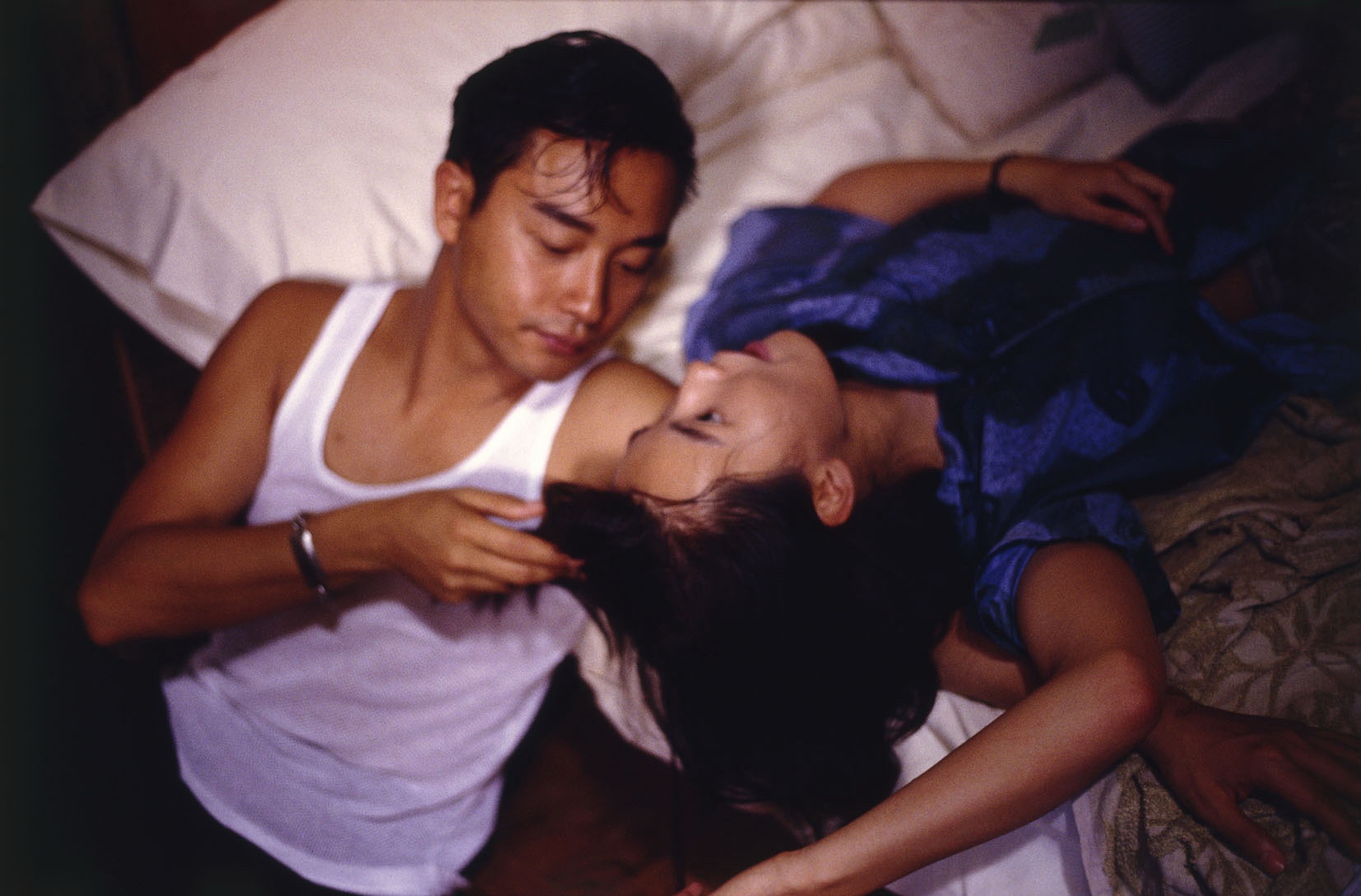
Days of Being Wild offers none of the however-slight conclusion at the end of Tears. It is Wong’s first decided step in the restless journey for self-discovery and permanence. A handful of characters are presented in their daily lives, seen alone at work or home, colored by their private thoughts and feelings about time, being, and belonging. The heart of the film is how people deal with rejection: the women are discarded by the same man and in the same manner, but deal with their pain in different ways.
The man himself deals with an even more private conflict, inconsistent feelings about his former-prostitute adoptive mother, and the absence of his biological mother, a Filipino aristocrat. The film crosses borders in both time and space, portraying the inner as well as literal journeys of the characters. In this way equal weight and emotional depth is given to the jilted lovers, the womanizer, his candid and self-effacing sidekick, and a solitary policeman.
In Days of Being Wild, Wong introduces his evocative disruptions of plot, wherein an presumably minor character is shifted to the foreground. Here, this is accomplished through voice-over; the night patrolman, his romantic love having never materialized, leaves Hong Kong to realize his dream of becoming a sailor abroad.
However, this departure remains within Wong’s realm of unremitting longing: the former-policeman now-sailor meets the young philanderer in the Philippines, on his own unfulfilled search for his biological mother. This is the beginning of Wong’s contemplation on chance, fate, and free will, which will remain at the center of his subsequent works.
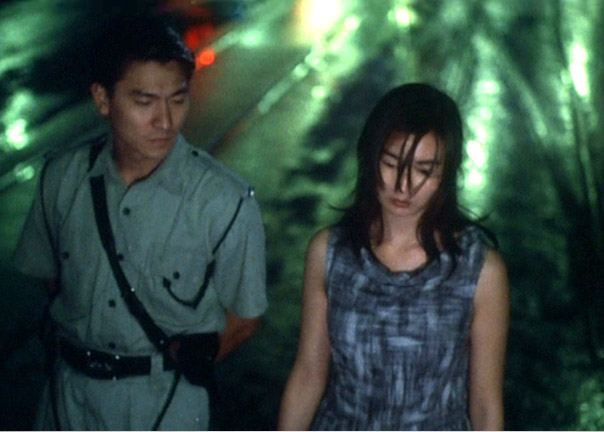
Here, all love is unrealized and insignificant. Each of the rejected women are sought by other men on the periphery, whom they either use, ignore, or otherwise fail to accept in turn. Plot-wise, little happens as these characters haphazardly navigate their daily lives and spend their time in wait, unaware that opportunity has passed them by.
They are all victims of time, change, and issues of identity and belonging in Wong Kar-wai’s 1960s Hong Kong. However, in the final scene, there is the suggestion of an enduring human spirit. At once troublesome and evocative, the end of the film sees the minor character played by Tony Leung – who will star in In the Mood for Love and 2046 – getting ready for a night on the town, and departing his cramped room.
After testing the waters with Tears, Days of Being Wild jumps on in to the boundless oceans of inexpressible sufferings. In his second film, Wong eschews plot and fully follows the emotional whims of his characters with utmost faith in their integrity. Wong’s approach is nonjudgemental, as there is no good and bad in the longing for intimacy and connection, self-knowledge and substance. There is only individual’s journey, and the unfortunate consequences as we recklessly grasp at fulfillment.
3. Ashes of Time (1994)
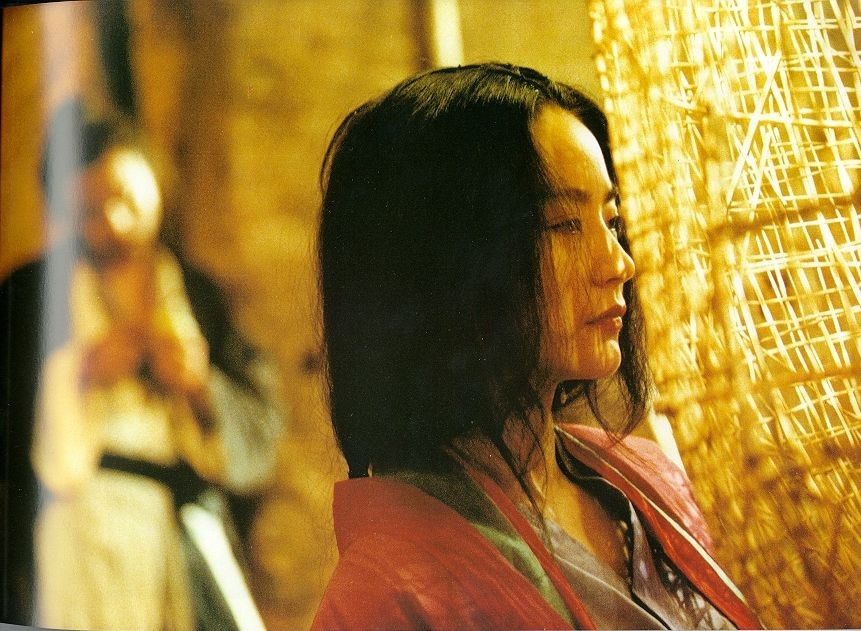
Ashes of Time presents as Wong Kar-wai’s perhaps most challenging film to date. It lacks the context and specificity of the Hong Kong settings in his other films, where any outside travel serves as a punctuation in the narrative. Instead, Ashes tells the story of an agent by the name of Ouyang Feng, and the several bounty hunters he hires. The film is technically an adaptation of the novel The Legend of the Condor Heroes by Jin Yong. However, Wong only uses the novel to loosely base his film on four of the characters, throwing out all plot adaptation. The result is a film that, despite its departures, is very much of the director’s spirit.
Ashes is a mood piece of a film. The story spans years, however, the characters are never removed from the deserts of Ancient China and there are no other indicators of chronology. The desert is an entrapment for all of the characters – a place of uncompromising necessity and self-sufficiency. Human beings are reduced to the most primal modes of survival.
Through the main character, Feng, Wong explores the cyclic nature of betrayal. A character who makes his living by convincing others that, surely, there must be someone they want killed, is from the very start both a victim and perpetrator of this corrosive force. As it turns out, Feng’s contempt for human life stems from a very intimate betrayal in his past.
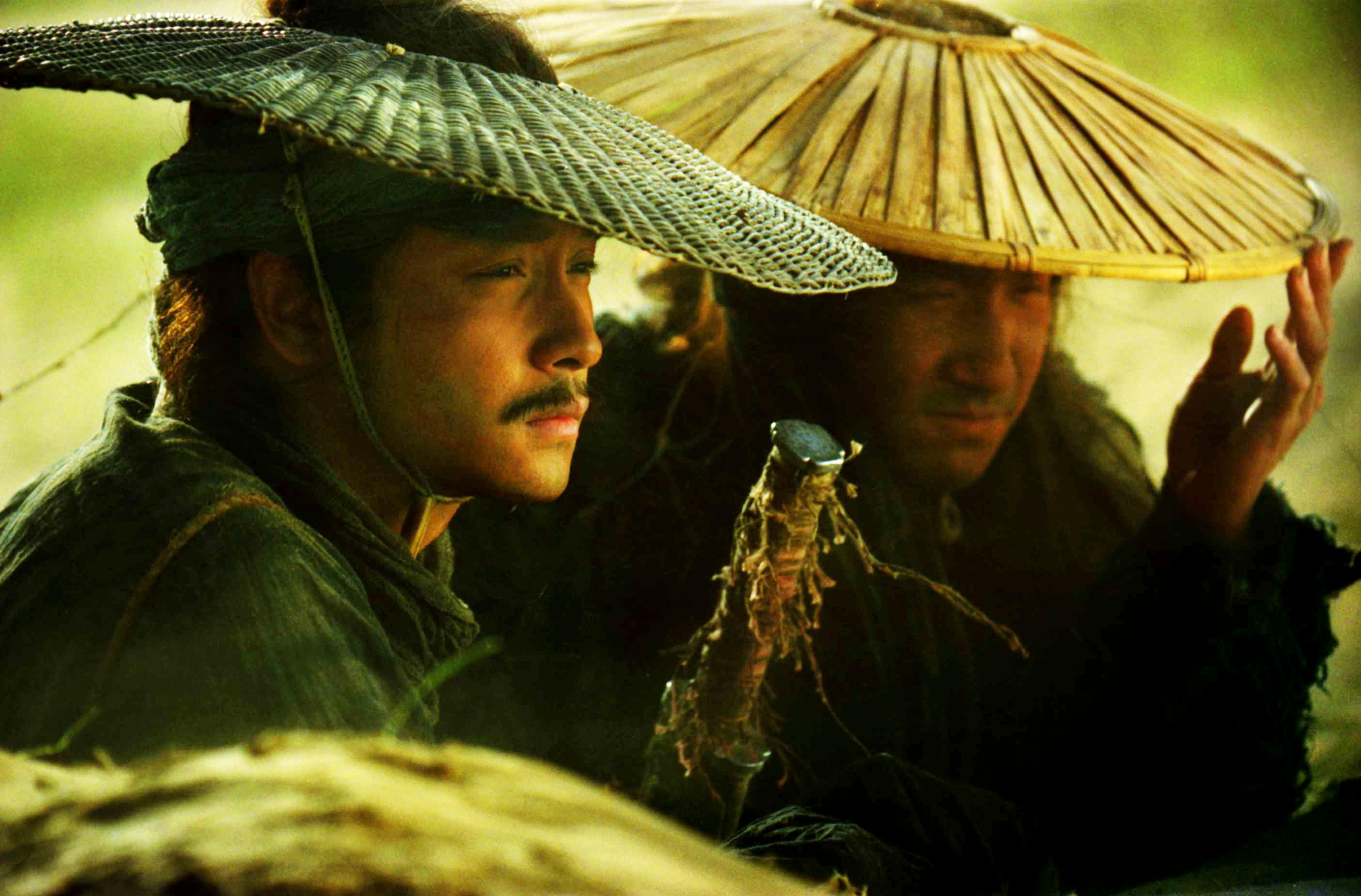
Blindness in various forms appears throughout Ashes as both a consequence and a saving grace from this vicious cycle. There is the blind swordsman, who wants to make the most of his remaining vision while he still has it; the swordsman who practices against his reflection; the blindness to the consequences of actions. A wine which has the power to make a person forget his past is seen throughout, as one of the characters offers that, “Man’s biggest problem is that he remembers,” or else, every day could be a new beginning.
However, some people refuse this form of blindness, a gesture symbolic of the unwillingness to forget past betrayals and driving pains. These malignant forces have become their only form of sustenance in the desert. Each character, at least initially, acts in spite of others, a rejection or reproach for human decency. A consequence of betrayals, it is better to hurt than to be hurt.
However, many of the characters find their way out of this blindness, either through love or some act of humanity. In the end, there is redemption from this such spiritual deprivation and isolation. The desert becomes a symbol of self-exile, in which character come to reflect upon how their life choices have led them to where they are, physically and metaphorically.
Ashes of Time purports to be a story about vengeance, but as that cycle has no end, the film must have a more decisive meaning. Ultimately, then, the film is about how one comes to terms with his or her burdens, and closes the gaps of the past. It is about the perspective with which that individual looks forward. As one character wonders what could beyond the distant mountains, another answers, “another desert.”
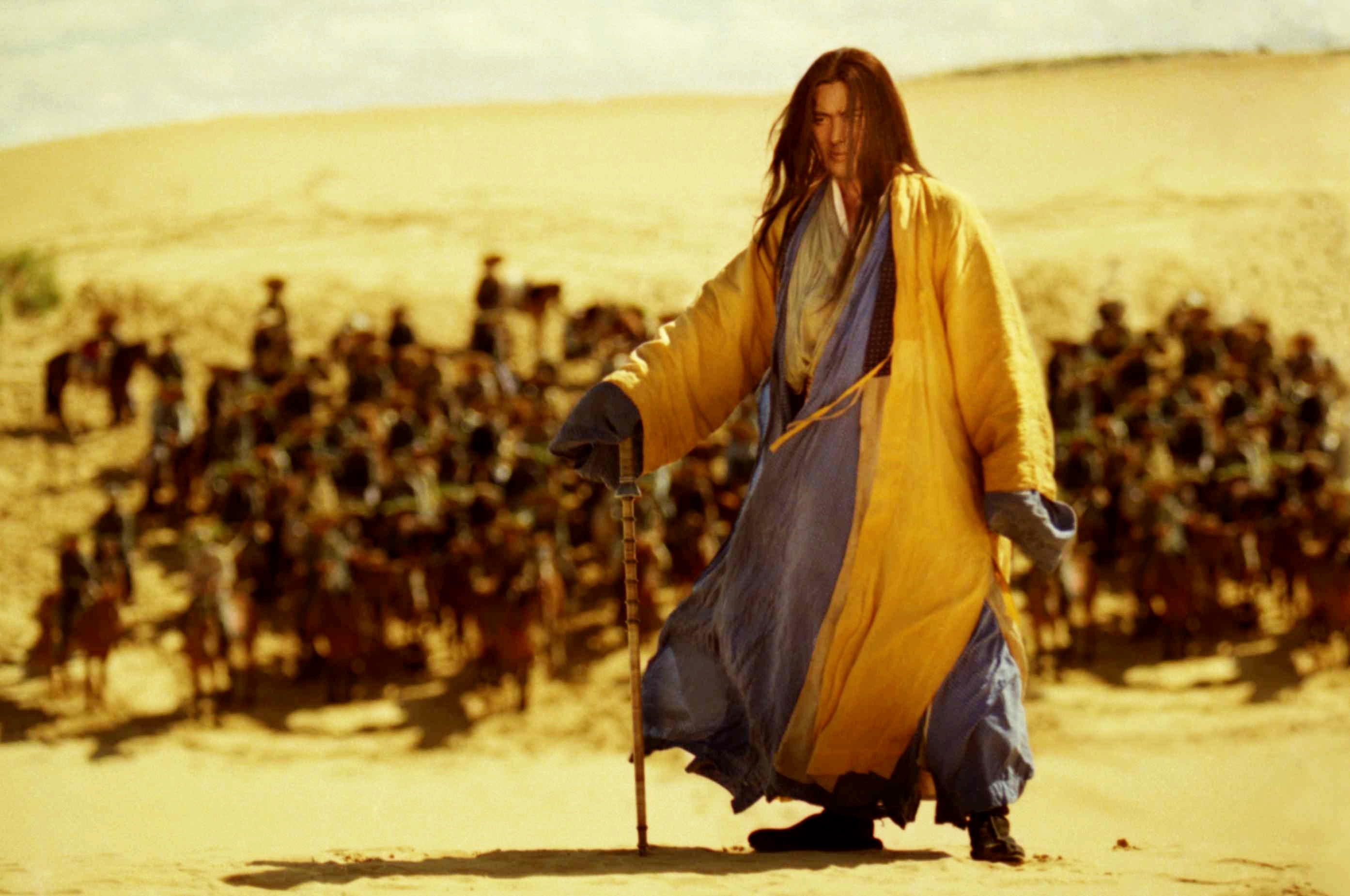
Feng’s refusal to look into a different future is his ultimate failure; he condemns himself to the desert. He longs for the past, the opportunities, mistakes, and regrets gone by. This is the greatest connection Ashes establishes to the rest of Wong’s body of work. However, where Wong’s other films deal with these themes in modern settings in which characters sit idly by and dwell on the past through their daily activities, Ashes is much more understated in its presentation.
The desert setting demands survival; it fosters a preoccupation with actions, and illusions. While people in contemporary Hong Kong are free to fully embrace their emotions behind closed doors, the deserts of Ancient China manifests mirages of necessity, a blindness toward one’s inner life.
4. Chungking Express (1994)
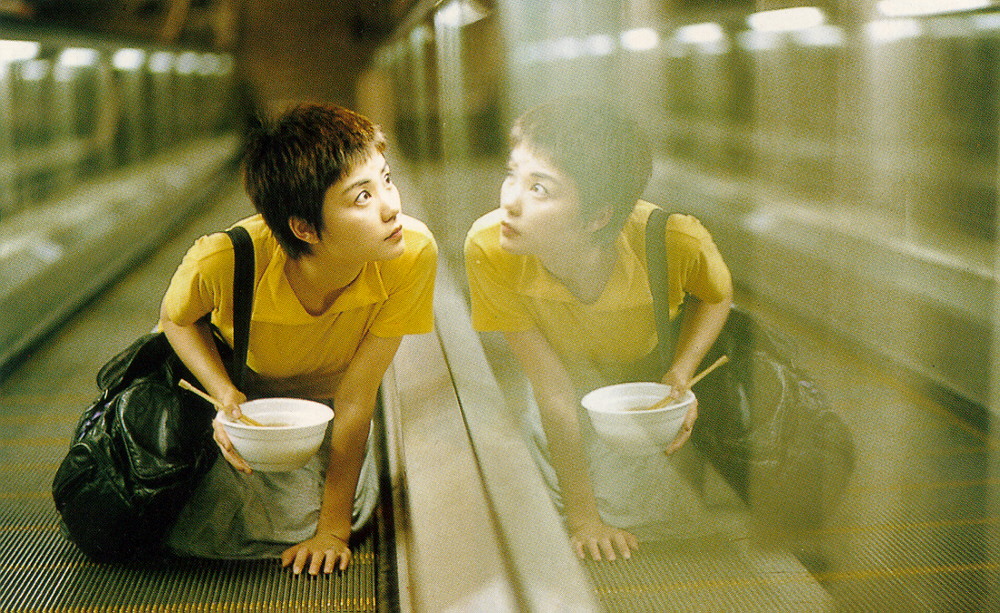
Filmed during a two-month break from editing Ashes, Chungking Express deals with similar themes in a relatively more lighthearted, contemporary story. The film is divide into two parts, each concerning a lovesick policeman who is getting over a breakup. Each story has little to do with the other except for a brief intersection where the first ends and the second begins. The film juxtaposes a densely populated Hong Kong with the isolated inner worlds of characters’ memories and nostalgia.
This paradox materializes through Wong’s frenetic handheld camera, deeply saturated florescent light, a restless editing pace, and a contemporary-pop soundtrack. Hong Kong is rendered in all of its modernity, while at the same time externalizing the emotional confusion of characters. Here, the director once again draws attention to the underlying connection between people and their time and place, depicting the private lives and relationships of individuals as results of their culture.
In fact, the English title “Chungking Express” is a collision of the films settings, the Chungking Mansions and Midnight Express food stall, and all of their physical and symbolic import.
If the first story is about unconsummated love, then the second is about unmaterialized love. In the second story, Faye, the snack shop girl, longs for Cop 663 from afar, even as he dwells on his ex-girlfriend. While He Qiwu and the drug smuggler are unrelated until they are brought together by their shared misfortune near the end of the first story, 663 and Faye are in constant physical proximity.
In scenes where 663 waits in the snack shop, Faye dances around to her favorite music and steals glances at him; when he catches her they share only a few words here and there. During the days, she breaks into his apartment and cleans the spaces in which he relives memories of his flight attendant girlfriend. The romanticism with which Wong manifests these memories is pure nostalgia. A free floating camera breathes in the steamy air of the couple on a hot afternoon, and 663 narrates these memories with the hindsight of his dashed dreams.
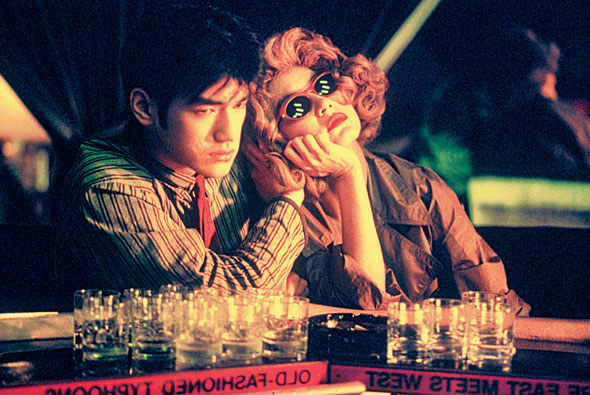
Love is ever-elusive in a world where no one is quite ready to act on their emotions when opportunity presents itself. When 663 and Faye eventually entertain the possibility of each other, Faye flees, repressing her feelings for fear of losing her freedom. This itself is a paradox that is continually explored in Wong’s work: the potential for joy in self-sacrifice, a whole that is greater than the sum of its parts. In a sense this the director’s caution to his audience, to make oneself as emotionally available as humanly possible.
Despite this, the second story and its conclusion is considerably more elevating than the first. Even with its poignant commentary on the tenuity of relationships and possibility, the second story offers a sense of balance in this troubling reality. The first story only leaves the viewer with a sense of what could have been – the characters of policeman and drug smuggler merely dramatize their failure to connect. However, here, too, the director offers an emerging insight, that sometimes a camaraderie between lost souls can be enough.
Common in Wong’s work, plot coherence is not a concern of the film. The narrative takes unannounced leaps in perspective and – as seen in Days – seemingly unrelated characters are given equal attention. Rest assured, even characters who never meet in Wong’s films are connected; thematic and emotional ties run through all examined lives. However, this approach to narrative can be troublesome for viewers.
Wong’s unconventional and expressionistic treatment can be hard to follow, but the symbolism and subtlety of poetic gestures lend a poignant gravity to the film as a whole – expiration dates, cans of pineapple, the preoccupation with “freshness.” Wong’s sympathies for the private and romantic are not found in carefully drawn plot points, but in small acts of personal significance, the gesture of a boarding pass drawn on a napkin or a spare glass hidden away until it’s needed (As Tears Go By).

The director traverses the most sensitive terrain of human needs and desires as a poet, through imagery and sound, the juxtaposition of the inner and outer, and utterly expressionistic flourishes of humanity. Chungking Express is perhaps the most seminal of Wong’s early films. While Ashes presents a profoundly elliptical narrative, it is Chungking Express that captures the true essence of intimate lives in modern Hong Kong. It is the very timeliness of this work – and those to follow – that establishes Wong Kar-wai as a voice of eternal human longing, at once nostalgic and prescient, but always of the moment.
5. Fallen Angels (1995)
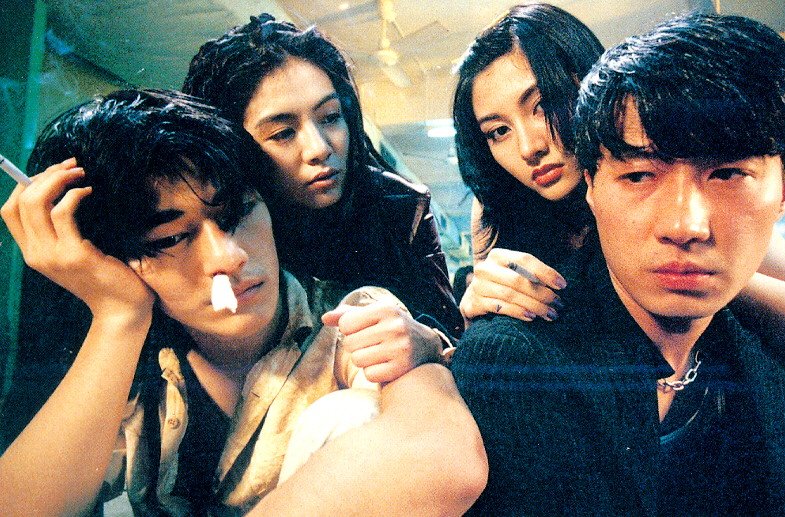
Fallen Angels can be assessed as a companion piece to Chungking Express – the same settings, aesthetics, and themes abound. Like Chungking Express, Angels presents two stories that have little to do with one each other besides a few chance encounters between the characters.
The first story concerns a hit man and a woman referred to as his “partner.” The two rarely rarely interact, but the woman cleans up his apartment and sends him the information for his hits. The second story concerns a delinquent young man, Ho Chi Moo, who has escaped prison and lives with his father. The woman from the first story happens to live in their building.
As extensions of Chungking Express, both of these stories deal with the existential implications of modern life in Hong Kong, i.e. alienation and loneliness despite the dense physical proximity of people. This conflict is reinforced by the spatial relations that Wong establishes; locations are revisited, characters seems to just miss each other, in passing, unaware of the camaraderie in their feelings, so to speak.
The result is an overwhelming repression of needs and desires. Wong’s characters are not ignorant of their feelings but their trouble is that they do not express themselves. This manifests as violence or a mentality of fatalism, emotional volatility masquerading as nihilism.
The hit man in the first story embodies this repression. In voice-over, he explains that one’s career is intrinsically linked to one’s personality: as a contract killer, he doesn’t have to make any decisions; someone else decides who should be killed, when and where. He is effectively removed from his profession. Murder distorts time; when he does his hits multiple juxtaposed camera angles refract and repeat the violence, gunshots fall out of sync, and the man’s affect is cold, removed. The repression of characters’ innermost feelings creates this metaphysical gravity, a distortion of time and space.
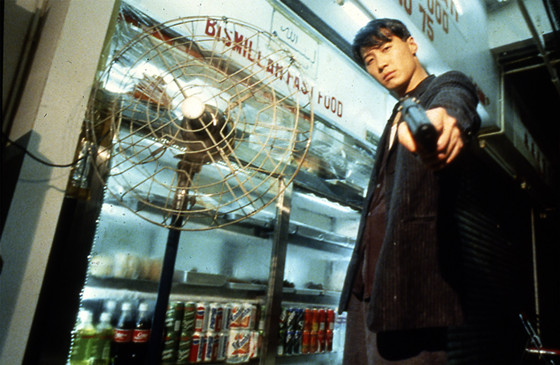
This is most effective in moments with the hit man’s partner. She is perhaps the most alone of all the characters in the film, and this loneliness often manifests in heavily distorted aesthetic choices. In an early scene where the woman is in the bar where the hit man often hangs out, images of glowing orange liquid coursing through the jukebox induce an almost hypnotic state.
Together with the musical choice (“Speak My Language” by Laurie Anderson), the effect is haunting as the woman daydreams about the man. Her longing and desire bubble beneath the surface before Wong cuts to the swirling neon-washed Hong Kong night, and finally the woman’s repression culminating – temporarily – as she masturbates in the man’s bed.
Early on in the film, the hit man briefly meditates on the nature of strangers, precluding his run in with various characters who will effect his life in various ways. It also becomes a contemplation on identity when strangers are mistaken for characters of one’s past. The willingness of an eccentric prostitute to accept the hit man as her ex-boyfriend becomes something of a revelation for him.
Upon recognizing such emotional vulnerability, he enacts to effectively make a decision in his life. Seeing into the sufferings of another person, in essence, allows him to accept the responsibility for his complicated relationship with his partner. This realization that he must account for his actions comes too late for him, but it strikes Wong’s resonating thematic chord at the center of our modern lives.
The second story concerns Ho, the escaped convict, and his alienation as opposed to the fatality in the first story. A mute who lives with his father, Ho spends much of his time in hiding and goes out at night to reopen shops and sell their goods to unwilling customers. When night after night he runs into Charlie, who is trying to get over her ex-boyfriend, his life is changed forever as he experiences a fulfilling love.
There is a suggestion that the girl’s ex was stolen from her by the same prostitute that the hit man spends time with, and thus he is the man she is trying to get over. This intangible connection between characters is a trademark of Wong’s work; people who never meet – or the audience never sees – are related to others in subtle and often romantic ways.

Even in Charlie’s company, Ho is alienated, as he is never the focus of her attention. He accepts his position as he falls in love with her, but he is ultimately forgotten. He escapes a physical isolation into another, deeper kind. His strange, forced interactions with people in the middle of the night are his only form of human contact. These incidences are always comical rather than threatening; his “customers” are sympathetic rather than frightened.
There is a lightheartedness to these scenes, a sense of brevity and innocence. However, Ho, too, eventually must take responsibility for his actions, as the hit man learns, but this revelation is no means of a payoff in terms of any kind of fulfillment.
Wong’s characters learn about themselves through their experiences – issues of identity being the crux of all human isolation and longing – but this in no way guarantees genre expectations. In Wong’s films, the revelation of the individual is often inconsequential, sometimes fatal, but the emphasis remains on the individual. The troubled relationships between characters all return to the broken identities that make them up.
Wong’s preoccupations with time, memory, and nostalgia enact both a transient and an eternal quality at the same time. Wong insists that one’s identity – and the tragedy of the human condition – is understood through such sufferings of the soul. By experiencing loss, regret, and reflection, we are intimately acquainted with the very transience that gives weight to our humanity.
6. Happy Together (1997)

This film marks one of Wong Kar Wai’s most cohesive works, in terms of both his aesthetics and thematic intent. Led by such opposing forces as Leslie Cheung and Tony Leung, Happy Together tells the story of two lovers caught in an abusive cycle of destruction and dependency. Cheung reprises a role similar to his character in Days of Being Wild, an uncommitted and emotionally vapid lover, Ho, while Lai, played by Leung, is prey to his endless promises of starting over.
Common in Wong’s work, the film begins with a character speaking in past tense via voiceover, contemplating the consequences of actions yet to happen. More than in any other of his films, Wong deals most directly with cycles and their effect on people here. The two men have traveled to Argentina in an attempt to renew their relationship, but before long Ho leaves Lai again. Wong makes exceedingly drastic aesthetic choices to visualize Lai’s emotional chaos as Ho emotionally tortures Lai.
An unpredictably shaky camera searches for its bearings, music selections pop into moments of fitting, and garish neon light soak the walls of interiors – a color palate that is at once putrid and beautiful. At this point, the usually detailed-oriented Wong is not so much concerned with legibility as he is with impressionism, capturing his character’s inner turmoil and turning it inside out.
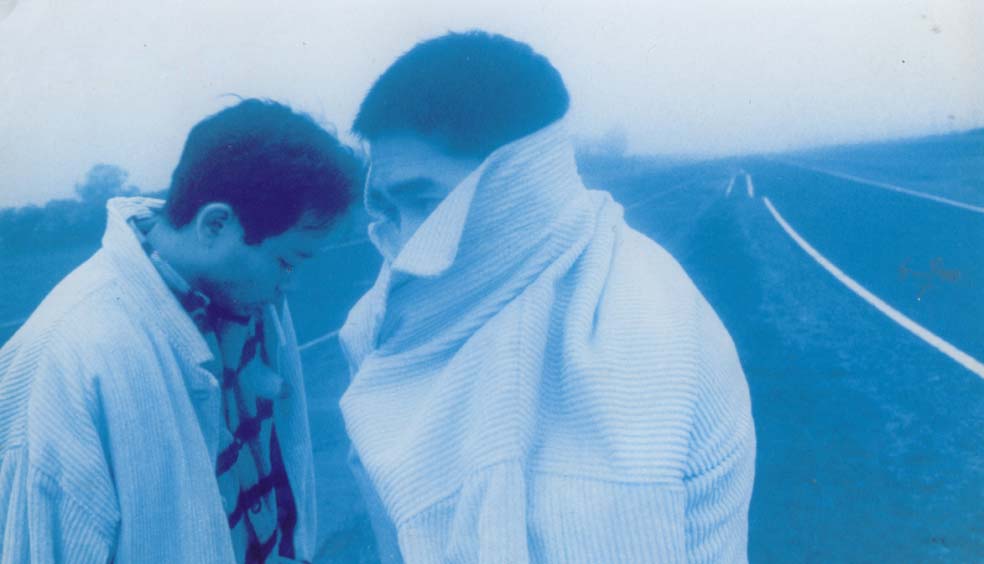
As Wong would have it, Ho shows up at Lai’s door beaten to a pulp and in need of care. Lai takes him in, but keeps him at a distance both physically and emotionally, despite Ho’s advances. Eventually, though, Lai relents. Lai remarks in voiceover that this was the happiest he’d ever been, despite his awareness that Ho’s affection is contingent upon his dependence.
This is thematically significant as a key to understanding Wong’s work as a whole. Dramatic “logic” – as one would assume – is thrown to the wayside to instead focus on the director’s true interests; despite awareness and logic, Lai cannot leave Ho because he is entrenched in the most eternal conflict: an individual in the face of faltering ideals. Of course, there is the physical conflict of isolation in a foreign place, Lai as an expatriate in Argentina with no immediate means of getting home, but this is a relatively simple narrative concession granted which helps to reinforce the singularity of his true conflict.
Wong assures this reading through the leitmotif of the Iguazu waterfalls, the initial reason for Lai and Ho’s trip to Argentina. In these images, the camera floats over the falls just long enough to induce meditation, and then they’re gone. This location is attributed symbolic significance, another trademark of Wong’s work; as some places become significant based on what occurs there, the falls represent an unrealized potential, a looming ideal that has since lost its perceived meaning.

The director confronts cyclical human nature most directly through Lai’s final rejection of Ho. Lai is unsurprised by Ho’s abusive behavior when he recovers, but his sadness transforms into dignified anger and a commitment to his own emotional well-being. Lai is ultimately able to reject Ho and realizes through friendship that his relationship with Ho is an ideal which cannot exist.
However, even his friendship must end, and at his lowest Lai comes to finally understand Ho. Again, Wong’s characters’ resolve come from experiences of considerable emotional depth. From his shattering ideal of love, to his redeeming friendship, and then his complete alienation, Lai is able to gather the pieces of his identity and confront his past.
In this film, Wong effectively closes off the cycles that he sets in motion, or rather, realizes his characters trapped within. Naturally, there are loose ends, but Happy Together feels like the director’s most cohesive work up to this point. Here, he seems to have stuck a balance between his narrative predilections and thematic intent.
7. In the Mood for Love (2000)
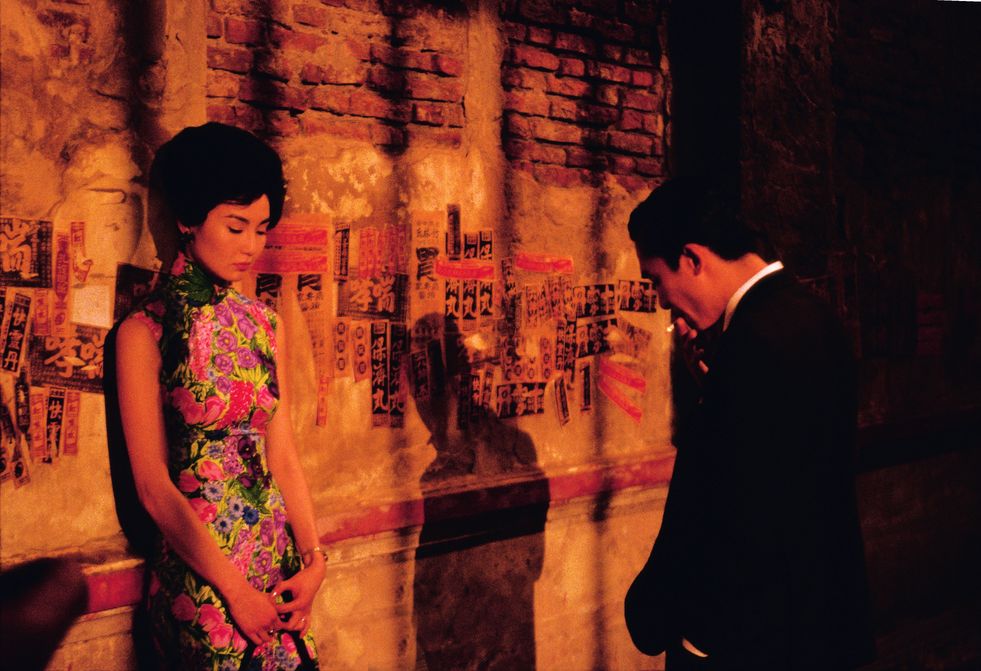
Widely regarded as Wong Kar-wai’s masterwork at this point in his career, In the Mood for Love constitutes the second entry into his informal trilogy (Days of Being Wild, 2046). Set in 1960s Hong Kong, this film bears all the marks of Wong’s Romantic vision –– isolation in densely populated areas, longing for intimacy and fulfillment circumscribed by social forces, an urban setting which at once exudes nostalgia and modernity. At the forefront are Su Li-zhen and Chow Mo-wan, played by Maggie Cheung and Tony Leung, respectively. This film, and those aforementioned, create a story of boundless emotion and eternal longing which supersedes any narrative discrepancies.
On the same day, Su and Chow both move into an apartment building and become neighbors. Each of them has a spouse who frequently leaves them alone to work late, and despite the friendly landlady, Mrs. Suen, they each find themselves alone, confined within the thin walls of their apartments. Wong capitalizes on motif, allowing locations and actions to take on meaning through repetition, nuance, and subtle changes.
Everyday interactions and chance encounters defy common romantic genre expectations. The characters’ lives intersect to no avail; Su and Chow frequently cross paths on their way to and from the street noodle stall, exchanging silent greetings and continuing along. Rather than linger on these encounters, Wong instead focuses on the characters separately, the banality of everyday unfulfillment. This conceit is, in fact, an outright declaration in the original Chinese title of the film, which refers to a metaphor for the fleeting nature of time, beauty, and love. It is a longing which permeates the core of the characters’ souls.
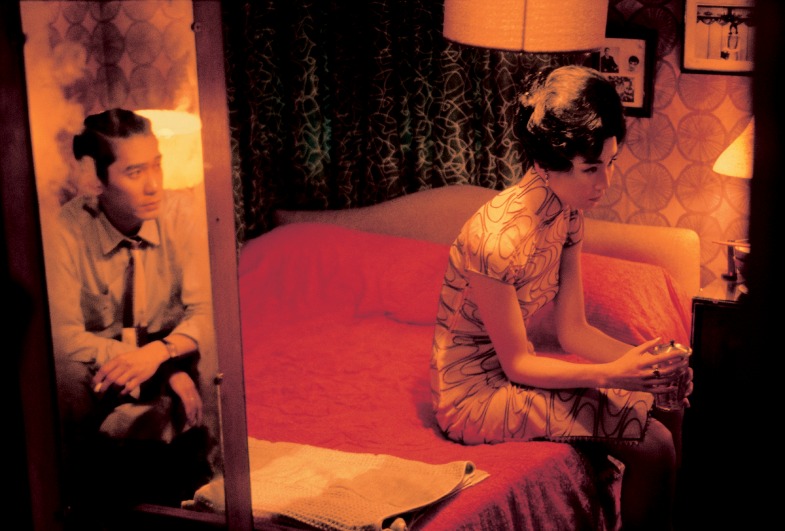
The inevitability of the characters’ union is set into motion by their shared realization that their respective spouses are seeing each other. Even from the start, this bonds Su and Chow together in a plainly platonic sense, thus their relationship begins. And their relationship is innocent in that Chow asks Su to help him write a martial arts serial for the paper he works for. However, in the social context of the times, even this solicits speculation, so Chow rents a hotel room where they can work in secret.
The two seemingly trade their isolated apartments for a rented room and begin to share meals together, a reversal of the earlier motif of separation. As their relationship develops they discover that they have feelings for each other, but their feelings never materialize as it is implied that they are morally above their spouses. This illustrates a conviction of Wong’s vision, that while the social norms and conflicts of modernity are hinderances upon human connection, issues of morality are ultimately held in opposition to fulfillment. It is the ever-present conflict between the daily life of the individual and the ideals he or she aspires to.
When Chow confronts his feelings and asks Su to leave with him, she fails to accept – a mere fault of chance, or an eternally departed potential. Even the attempt to reach out by one character ends in checking herself against doubt. The eventual transgression of the platonic boundary placed on their relationship is a direct consequence of their unrelieved repression. However, despite the acknowledgement of this gesture, their feelings still fail to materialize.
Emotions bubble beneath the surface until they demand expression, but the characters are always restrained by a fear of the same sense of emptiness that they presently suffer from. A pervading nostalgia harbors all missed opportunities, regret, and moral contemplations faced by the characters, continually leading them into conflict with the ideals they long after. The pattern of missed connections juxtaposed with physical proximity thus becomes another contemplation on chance and fate, a predetermined loneliness or the tenuity of fulfillment. Either way, lasting happiness is always just out of reach.
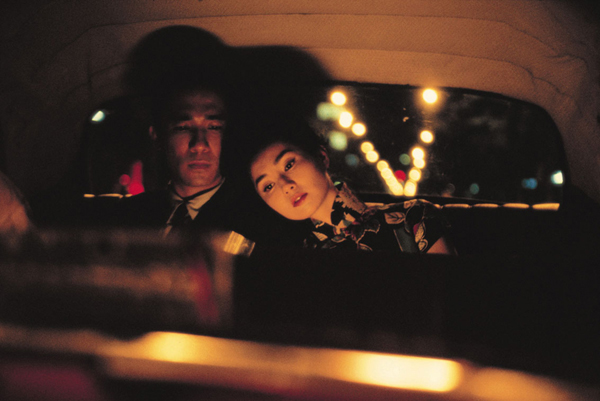
At the end of the film, the director again creates a symbolic tension from a particularly meaningful location. Chow fulfills a prophecy made earlier in the film when he journeys to the Angkor Wat in Cambodia and whispers a secret into a wall and covers it. This is the repression at the core of Wong’s sensibilities as a director.
The ultimate inhibition of peoples’ emotional freedom and fulfillment is not social, not even moral, but it is the lack of self-understanding, and therefore the means to connect with others. Despite the influences of chance, fate, and free will, Su and Chow never allow their true emotions to bloom. What remains is a silent resignation, a memory, a secret of another life which may as well have been a dream.
In the Mood for Love is Wong Kar-wai’s most lyrical film to date. It is a film which seeks to portray the individual’s inner life through image and sound. Wong Kar-wai fully establishes his dominion over the traditional narrative. His refusal of such structures is not a rebellion against them, but a necessity of the material he serves. The exploration of such intimacy, repression, and longing depend not on plot developments but one’s experience of everyday life.
The director enlivens his characters’ surroundings with such beauty and poetry that their isolation is a natural contrast to the possibilities of life. With In the Mood for Love, Wong Kar-wai situates himself as one of cinema’s most contemporary Romantic tragedians.
8. 2046 (2004)
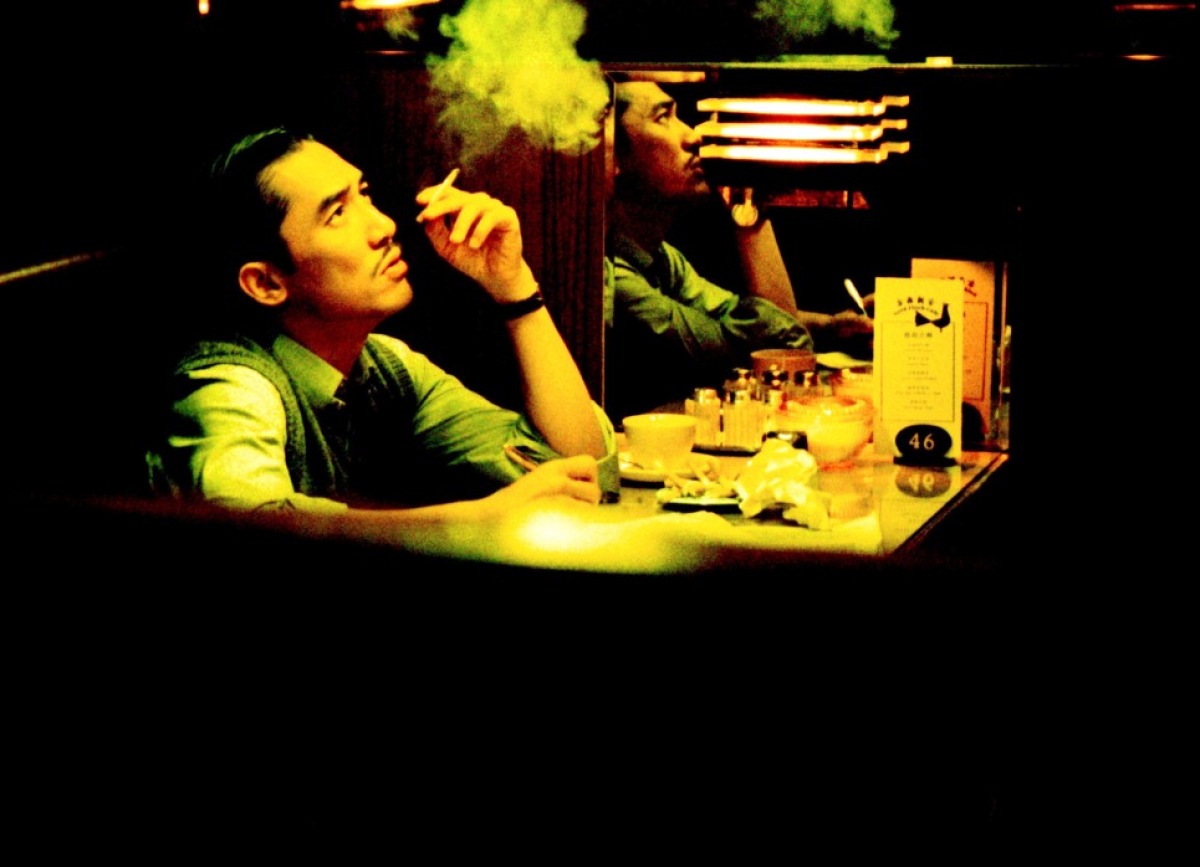
The concluding chapter of Wong’s informal trilogy is by far the most complex. 2046 is comprised of four stories woven together without respect to any chronology. Three of the stories are about Chow’s (the role reprised by Tony Leung) relationships with other women after losing Su Li-Zhen. The fourth story takes place in Chow’s science-fiction fantasy, the titular “2046.”
The structure of the film inherently modulates the viewer’s experience to be something more akin to memory than its mere representation. In this film, Wong Kar-wai seamlessly merges form with function; one experiences this film individually, taking away whatever resonates most in its subtle progression of tones and moods. In this way, synopsis is of little value, and a single viewing does not suffice to gleam Wong’s delicate sensibilities here.
At the heart of the film is Chow’s conflict of getting over Su Li-Zhen while still longing for the ideal that she represents. Wong maintains thematic consistency from In the Mood for Love while still making 2046 thoroughly original. This is largely due to the infusion of science-fiction elements – which resound poignantly and without contrivances throughout the film – but also Wong’s sensitivity to tone.
Like its predecessor, this film deals with the repression of not only one’s emotions but of one’s identity. However, where In the Mood for Love probes the nature of loss, 2046 explores how one attempts to recover from it. In time, such depression callouses, and the director navigates the transition with unabashed humanity.
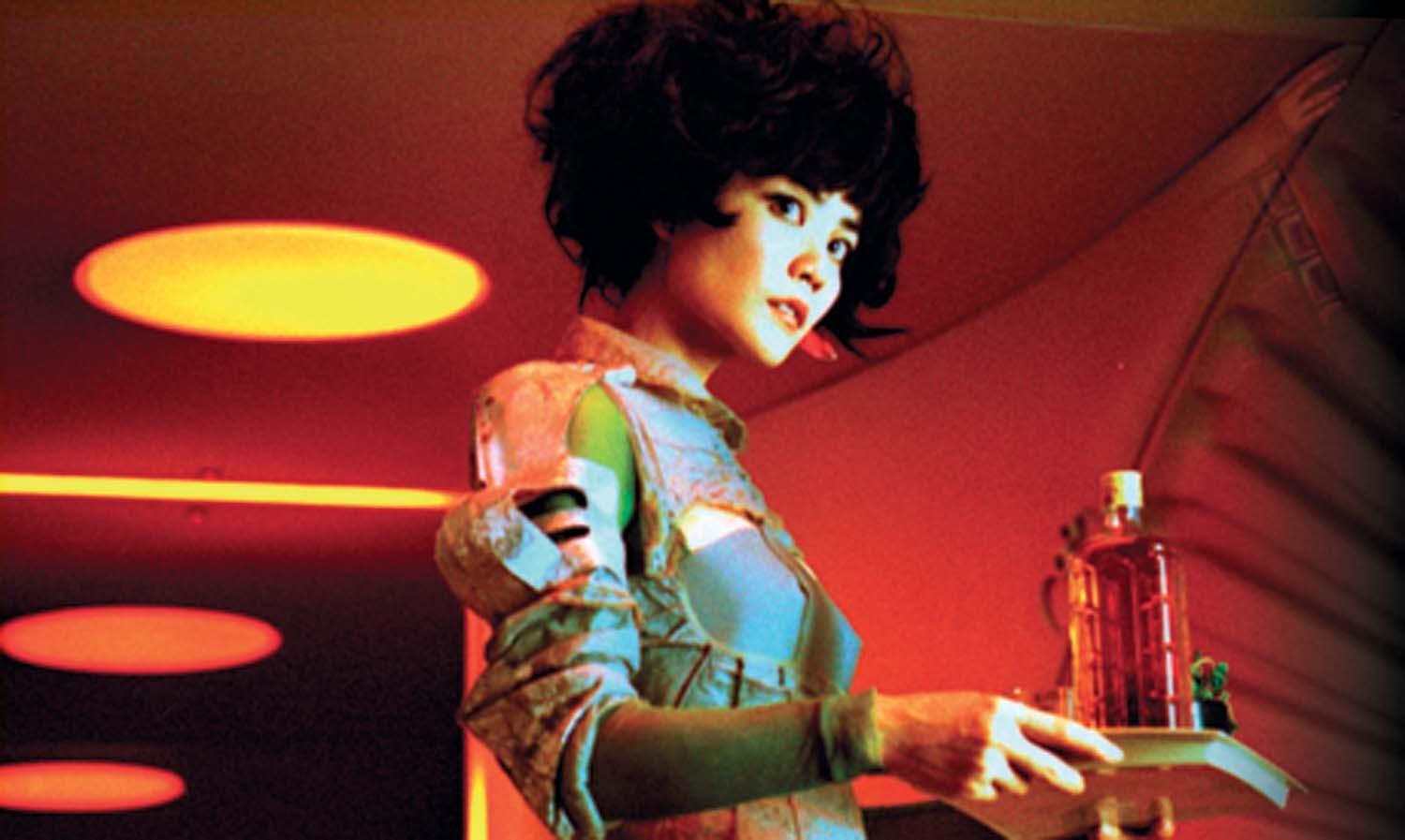
Aesthetically, the film marks a deviation from Wong’s previous work. Rather than render his interiors in harsh florescent colors, the director opts for a cleaner look. Whereas his previous films saw characters bathed in whatever the ambient light, 2046 feels more balanced. Faithfully rendered skin tones pop from color-controlled sets, often charged with red-green, green-blue split-compliment palettes. Wong exceeds his own high standards of detail and meticulousness; every composition has a specific weight and impact, and visual symbols such as mirrors, windows, and other means of separation or looking-in abound.
One crucial moment shows Chow on the street outside of his office, looking through the window at a woman he has feelings for as she talks to her ex-boyfriend on the phone. He watches how happy she is as the neon lights reflect back at him in the window. This moment presents a critical revelation on the path to Chow’s recovery. Each shot throughout the film renegotiates the shifting relationships between characters. Overall, 2046 feels like Wong’s most controlled, visually assured film up to this point.
The structure of the film does present significant difficulty in terms of overall comprehensibility. The chapters of the film move seamlessly throughout time and space, as well as other dimensions of reality, with only the slightest hints to the true chronology of events. Chow philanders through his life after Su Li-Zhen, and the chapters of the film focus on his relationships with three particular women – while quite a few more are implied. After losing his idealized love, Chow busies himself in the role of the much desired ladies’ man, however, his eternalized longing is never actually hidden.
The films begins with an introduction to Chow’s fictional world of “2046,” narrated by his main character. The future is a vast and lonely place where individuals try to recapture their lost loves by taking a long train ride to the world of 2046 – where, supposedly, nothing ever changes and is therefore idealized. Despite this degree of self-awareness, Wong’s theme-driven direction sees Chow through his attempts to satisfy – or at least quell – his longing through other people.

Gradually, Chow learns from his subsequent relationships that his idealized love is irreplaceable, and that his attempts to find Su Li-Zhen in others are morally and emotionally abject. Filtered through the director’s sensibilities and tonal acuity, though, the human condition is rendered as beautiful rather than lamentable. Where untamed carnality stands opposite of Chow’s true love, the most triumphant moments in Wong’s experience are those of warm affection and camaraderie, friendship – a balance and solidarity in life. Thus the director offers his remedy to the realities of heartbreak, isolation, and romantic longing.
Although 2046 lacks the containment of the director’s other works, its cinematic value remains unscathed. More poem than plot, chaos than order – the inventiveness, ambition, and scope of the film attribute to a peak in Wong’s profundity. The experiences and insights within are worth many times over the challenges they present.
9. The Grandmaster (2013)
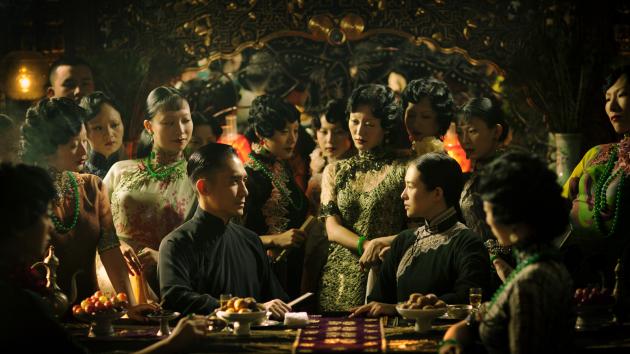
Wong Kar-wai’s latest film deviates from all of his previous work in a significant way. The Grandmaster tells the true story of Ip Man’s life and the rise of Wing Chun as a martial art. The film is thusly part biopic, part period piece, and part genre film. In form, it is quite different from anything the director has done before. However, in content and theme, Wong Kar-wai is present at his most compelling; he effectively concentrates his twenty years’ practice on the story of a man whose real-life struggles exemplify the themes that the director has dealt with all along.
Played by none other than Tony Leung, the Wing Chun grandmaster, Ip Man, proves to be the essential Wong Kar-wai protagonist. The move away from a contemporary Hong Kong setting is a move to expand the director’s cinema, as the story not only embodies his deepest thematic concerns, but goes back in time to critical events in mainland China’s history. The film is then comprised of yet another part: part invigoration of the Chinese national cinema. With The Grandmaster, Wong Kar-wai expands his oeuvre in both width and depth.
The film presents a refreshingly refined narrative; frame loosely around the Second Sino-Japanese War, it chronicles the events of Ip Man’s rise to grandmaster of the South, life, and legacy. However, the film devotes a significant amount of its narrative to following the longtime relationship between Ip Man and the daughter of the retiring Northern grandmaster.
Rather than explore his themes of fulfillment, connection, etc. in the foreground, Wong instead recognizes these elements in an individual whose stable life is shaken by real events. Thus, the film is effectively about before and after, a meditation presented throughout Wong’s work, often in the forms of regret and longing. The historical narrative, however, keeps the film moving. Wong doesn’t take the poetic license to linger but rather posits these moments between before and after for contemplation as they occur.

The Grandmaster deals with binaries on several levels. The first scene, a remarkable fight sequence in the pouring rain, serves as a kind of mission statement for the film. Ip Man himself provides the first binary to an unseen party: “Horizontal. Vertical.” In his thinking, this is the essence of Kung Fu, fall down or stay standing. And the ensuing street fight reinforces this conceit: Ip Man defeats a crowd of challengers without receiving so much as a single blow.
He fights with the kind of precision that looks effortless, despite the flurries of crushing blows and bodies flying through the air. It isn’t until a lone rival enters that the sheer physicality of the combat is understood. In fact, the effect presents yet another binary, the physical and metaphysical. Kung Fu is effectively a form of transcendence; despite its brutality, it appears as more art than combat.
This meditation on binaries and their transcendence into a more complex uniformity is realized at a critical moment. Ip Man’s“fight” with Gong Yutian, grandmaster of the North, is an exchange of ideas rather than a physical encounter, the ultimate marriage of two opposites in Kung Fu. From here, though, the film goes in a more familiar direction. With the retirement and defeat of her father, Gong Er becomes Ip Man’s lifelong adversary and friendly antagonist. Wong charts the relationship between these two characters – united opposites of North and South – through their letter correspondence and Ip Man’s concern for the vengeance that drives Gong.
The film centralizes on the juxtaposition of the characters’ lives after the war. While Ip overcomes his traumas and goes on to establish his school, Gong strays from her martial arts. At the heart of this juxtaposition is the camaraderie that binds the two together. Although it’s never so much as alluded to, the relationship between Ip and Gong is palpably romantic. That she falls in love with him is tellable from the first time she challenges him.
The fight choreography is more intimate than any other instance in the film, and Wong photographs it with considerably more close ups than the others. The camera focuses on ways to keep the characters together rather than favoring, including a dazzling overhead shot that sees the two more as dancers than combatants.

There is repression here as there is at the core of all Wong’s work. When Gong invites Ip to the North for a rematch there is already an implication that her invitation is more than literal. And of course there is more that separates the two than North and South. Instead of probing the moral consequences of longing – as in In the Mood for Love – Wong examines two individuals who are resigned to their separate paths, with martial arts as both a crucial and ostensible backdrop.
The director thusly strikes a similar thematic chord in a far more subtle way with this historical-genre film. The deftness and craftsmanship of The Grandmaster as a commercial production – this while preserving the intangible qualities that audiences view Wong Kar-wai for – is perhaps the most significant development in the auteur’s career to date.
In far greater respects than a departure from form, The Grandmaster is a bold statement in Wong’s career. His collaboration with China’s mainland film industry speaks to much more than a transition from art house to commercial interests. If Wong Kar-wai had guaranteed his legacy as one of the greatest Romantics of cinema prior to The Grandmaster, then perhaps it is already time for a greater appraisal of the director’s work.
Author Bio: Kevin Pementel is a Chicago-based filmmaker and film writer.

Widely regarded as Wong Kar-wai’s masterwork at this point in his career, In the Mood for Love constitutes the second entry into his informal trilogy (Days of Being Wild, 2046). Set in 1960s Hong Kong, this film bears all the marks of Wong’s Romantic vision –– isolation in densely populated areas, longing for intimacy and fulfillment circumscribed by social forces, an urban setting which at once exudes nostalgia and modernity. At the forefront are Su Li-zhen and Chow Mo-wan, played by Maggie Cheung and Tony Leung, respectively. This film, and those aforementioned, create a story of boundless emotion and eternal longing which supersedes any narrative discrepancies.
On the same day, Su and Chow both move into an apartment building and become neighbors. Each of them has a spouse who frequently leaves them alone to work late, and despite the friendly landlady, Mrs. Suen, they each find themselves alone, confined within the thin walls of their apartments. Wong capitalizes on motif, allowing locations and actions to take on meaning through repetition, nuance, and subtle changes.
Everyday interactions and chance encounters defy common romantic genre expectations. The characters’ lives intersect to no avail; Su and Chow frequently cross paths on their way to and from the street noodle stall, exchanging silent greetings and continuing along. Rather than linger on these encounters, Wong instead focuses on the characters separately, the banality of everyday unfulfillment. This conceit is, in fact, an outright declaration in the original Chinese title of the film, which refers to a metaphor for the fleeting nature of time, beauty, and love. It is a longing which permeates the core of the characters’ souls.

The inevitability of the characters’ union is set into motion by their shared realization that their respective spouses are seeing each other. Even from the start, this bonds Su and Chow together in a plainly platonic sense, thus their relationship begins. And their relationship is innocent in that Chow asks Su to help him write a martial arts serial for the paper he works for. However, in the social context of the times, even this solicits speculation, so Chow rents a hotel room where they can work in secret.
The two seemingly trade their isolated apartments for a rented room and begin to share meals together, a reversal of the earlier motif of separation. As their relationship develops they discover that they have feelings for each other, but their feelings never materialize as it is implied that they are morally above their spouses. This illustrates a conviction of Wong’s vision, that while the social norms and conflicts of modernity are hinderances upon human connection, issues of morality are ultimately held in opposition to fulfillment. It is the ever-present conflict between the daily life of the individual and the ideals he or she aspires to.
When Chow confronts his feelings and asks Su to leave with him, she fails to accept – a mere fault of chance, or an eternally departed potential. Even the attempt to reach out by one character ends in checking herself against doubt. The eventual transgression of the platonic boundary placed on their relationship is a direct consequence of their unrelieved repression. However, despite the acknowledgement of this gesture, their feelings still fail to materialize.
Emotions bubble beneath the surface until they demand expression, but the characters are always restrained by a fear of the same sense of emptiness that they presently suffer from. A pervading nostalgia harbors all missed opportunities, regret, and moral contemplations faced by the characters, continually leading them into conflict with the ideals they long after. The pattern of missed connections juxtaposed with physical proximity thus becomes another contemplation on chance and fate, a predetermined loneliness or the tenuity of fulfillment. Either way, lasting happiness is always just out of reach.

At the end of the film, the director again creates a symbolic tension from a particularly meaningful location. Chow fulfills a prophecy made earlier in the film when he journeys to the Angkor Wat in Cambodia and whispers a secret into a wall and covers it. This is the repression at the core of Wong’s sensibilities as a director.
The ultimate inhibition of peoples’ emotional freedom and fulfillment is not social, not even moral, but it is the lack of self-understanding, and therefore the means to connect with others. Despite the influences of chance, fate, and free will, Su and Chow never allow their true emotions to bloom. What remains is a silent resignation, a memory, a secret of another life which may as well have been a dream.
In the Mood for Love is Wong Kar-wai’s most lyrical film to date. It is a film which seeks to portray the individual’s inner life through image and sound. Wong Kar-wai fully establishes his dominion over the traditional narrative. His refusal of such structures is not a rebellion against them, but a necessity of the material he serves. The exploration of such intimacy, repression, and longing depend not on plot developments but one’s experience of everyday life.
The director enlivens his characters’ surroundings with such beauty and poetry that their isolation is a natural contrast to the possibilities of life. With In the Mood for Love, Wong Kar-wai situates himself as one of cinema’s most contemporary Romantic tragedians.
8. 2046 (2004)

The concluding chapter of Wong’s informal trilogy is by far the most complex. 2046 is comprised of four stories woven together without respect to any chronology. Three of the stories are about Chow’s (the role reprised by Tony Leung) relationships with other women after losing Su Li-Zhen. The fourth story takes place in Chow’s science-fiction fantasy, the titular “2046.”
The structure of the film inherently modulates the viewer’s experience to be something more akin to memory than its mere representation. In this film, Wong Kar-wai seamlessly merges form with function; one experiences this film individually, taking away whatever resonates most in its subtle progression of tones and moods. In this way, synopsis is of little value, and a single viewing does not suffice to gleam Wong’s delicate sensibilities here.
At the heart of the film is Chow’s conflict of getting over Su Li-Zhen while still longing for the ideal that she represents. Wong maintains thematic consistency from In the Mood for Love while still making 2046 thoroughly original. This is largely due to the infusion of science-fiction elements – which resound poignantly and without contrivances throughout the film – but also Wong’s sensitivity to tone.
Like its predecessor, this film deals with the repression of not only one’s emotions but of one’s identity. However, where In the Mood for Love probes the nature of loss, 2046 explores how one attempts to recover from it. In time, such depression callouses, and the director navigates the transition with unabashed humanity.

Aesthetically, the film marks a deviation from Wong’s previous work. Rather than render his interiors in harsh florescent colors, the director opts for a cleaner look. Whereas his previous films saw characters bathed in whatever the ambient light, 2046 feels more balanced. Faithfully rendered skin tones pop from color-controlled sets, often charged with red-green, green-blue split-compliment palettes. Wong exceeds his own high standards of detail and meticulousness; every composition has a specific weight and impact, and visual symbols such as mirrors, windows, and other means of separation or looking-in abound.
One crucial moment shows Chow on the street outside of his office, looking through the window at a woman he has feelings for as she talks to her ex-boyfriend on the phone. He watches how happy she is as the neon lights reflect back at him in the window. This moment presents a critical revelation on the path to Chow’s recovery. Each shot throughout the film renegotiates the shifting relationships between characters. Overall, 2046 feels like Wong’s most controlled, visually assured film up to this point.
The structure of the film does present significant difficulty in terms of overall comprehensibility. The chapters of the film move seamlessly throughout time and space, as well as other dimensions of reality, with only the slightest hints to the true chronology of events. Chow philanders through his life after Su Li-Zhen, and the chapters of the film focus on his relationships with three particular women – while quite a few more are implied. After losing his idealized love, Chow busies himself in the role of the much desired ladies’ man, however, his eternalized longing is never actually hidden.
The films begins with an introduction to Chow’s fictional world of “2046,” narrated by his main character. The future is a vast and lonely place where individuals try to recapture their lost loves by taking a long train ride to the world of 2046 – where, supposedly, nothing ever changes and is therefore idealized. Despite this degree of self-awareness, Wong’s theme-driven direction sees Chow through his attempts to satisfy – or at least quell – his longing through other people.

Gradually, Chow learns from his subsequent relationships that his idealized love is irreplaceable, and that his attempts to find Su Li-Zhen in others are morally and emotionally abject. Filtered through the director’s sensibilities and tonal acuity, though, the human condition is rendered as beautiful rather than lamentable. Where untamed carnality stands opposite of Chow’s true love, the most triumphant moments in Wong’s experience are those of warm affection and camaraderie, friendship – a balance and solidarity in life. Thus the director offers his remedy to the realities of heartbreak, isolation, and romantic longing.
Although 2046 lacks the containment of the director’s other works, its cinematic value remains unscathed. More poem than plot, chaos than order – the inventiveness, ambition, and scope of the film attribute to a peak in Wong’s profundity. The experiences and insights within are worth many times over the challenges they present.
9. The Grandmaster (2013)

Wong Kar-wai’s latest film deviates from all of his previous work in a significant way. The Grandmaster tells the true story of Ip Man’s life and the rise of Wing Chun as a martial art. The film is thusly part biopic, part period piece, and part genre film. In form, it is quite different from anything the director has done before. However, in content and theme, Wong Kar-wai is present at his most compelling; he effectively concentrates his twenty years’ practice on the story of a man whose real-life struggles exemplify the themes that the director has dealt with all along.
Played by none other than Tony Leung, the Wing Chun grandmaster, Ip Man, proves to be the essential Wong Kar-wai protagonist. The move away from a contemporary Hong Kong setting is a move to expand the director’s cinema, as the story not only embodies his deepest thematic concerns, but goes back in time to critical events in mainland China’s history. The film is then comprised of yet another part: part invigoration of the Chinese national cinema. With The Grandmaster, Wong Kar-wai expands his oeuvre in both width and depth.
The film presents a refreshingly refined narrative; frame loosely around the Second Sino-Japanese War, it chronicles the events of Ip Man’s rise to grandmaster of the South, life, and legacy. However, the film devotes a significant amount of its narrative to following the longtime relationship between Ip Man and the daughter of the retiring Northern grandmaster.
Rather than explore his themes of fulfillment, connection, etc. in the foreground, Wong instead recognizes these elements in an individual whose stable life is shaken by real events. Thus, the film is effectively about before and after, a meditation presented throughout Wong’s work, often in the forms of regret and longing. The historical narrative, however, keeps the film moving. Wong doesn’t take the poetic license to linger but rather posits these moments between before and after for contemplation as they occur.

The Grandmaster deals with binaries on several levels. The first scene, a remarkable fight sequence in the pouring rain, serves as a kind of mission statement for the film. Ip Man himself provides the first binary to an unseen party: “Horizontal. Vertical.” In his thinking, this is the essence of Kung Fu, fall down or stay standing. And the ensuing street fight reinforces this conceit: Ip Man defeats a crowd of challengers without receiving so much as a single blow.
He fights with the kind of precision that looks effortless, despite the flurries of crushing blows and bodies flying through the air. It isn’t until a lone rival enters that the sheer physicality of the combat is understood. In fact, the effect presents yet another binary, the physical and metaphysical. Kung Fu is effectively a form of transcendence; despite its brutality, it appears as more art than combat.
This meditation on binaries and their transcendence into a more complex uniformity is realized at a critical moment. Ip Man’s“fight” with Gong Yutian, grandmaster of the North, is an exchange of ideas rather than a physical encounter, the ultimate marriage of two opposites in Kung Fu. From here, though, the film goes in a more familiar direction. With the retirement and defeat of her father, Gong Er becomes Ip Man’s lifelong adversary and friendly antagonist. Wong charts the relationship between these two characters – united opposites of North and South – through their letter correspondence and Ip Man’s concern for the vengeance that drives Gong.
The film centralizes on the juxtaposition of the characters’ lives after the war. While Ip overcomes his traumas and goes on to establish his school, Gong strays from her martial arts. At the heart of this juxtaposition is the camaraderie that binds the two together. Although it’s never so much as alluded to, the relationship between Ip and Gong is palpably romantic. That she falls in love with him is tellable from the first time she challenges him.
The fight choreography is more intimate than any other instance in the film, and Wong photographs it with considerably more close ups than the others. The camera focuses on ways to keep the characters together rather than favoring, including a dazzling overhead shot that sees the two more as dancers than combatants.

There is repression here as there is at the core of all Wong’s work. When Gong invites Ip to the North for a rematch there is already an implication that her invitation is more than literal. And of course there is more that separates the two than North and South. Instead of probing the moral consequences of longing – as in In the Mood for Love – Wong examines two individuals who are resigned to their separate paths, with martial arts as both a crucial and ostensible backdrop.
The director thusly strikes a similar thematic chord in a far more subtle way with this historical-genre film. The deftness and craftsmanship of The Grandmaster as a commercial production – this while preserving the intangible qualities that audiences view Wong Kar-wai for – is perhaps the most significant development in the auteur’s career to date.
In far greater respects than a departure from form, The Grandmaster is a bold statement in Wong’s career. His collaboration with China’s mainland film industry speaks to much more than a transition from art house to commercial interests. If Wong Kar-wai had guaranteed his legacy as one of the greatest Romantics of cinema prior to The Grandmaster, then perhaps it is already time for a greater appraisal of the director’s work.
Author Bio: Kevin Pementel is a Chicago-based filmmaker and film writer.
Read more at http://www.tasteofcinema.com/2014/filmmaker-retrospective-the-poetic-cinema-of-wong-kar-wai/#mLlRkT5WuvyMv43D.99